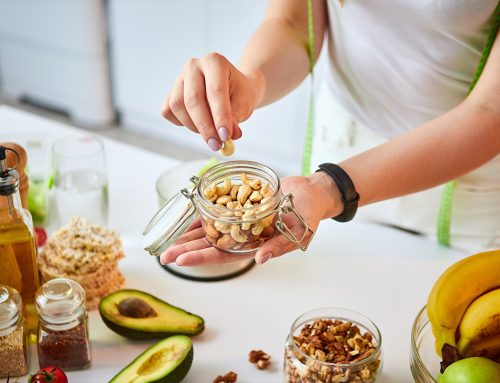Carbohydrates. Everyone seems to have a strong opinion about the body’s first energy source, but the fear surrounding them may be unnecessary—even when managing blood sugar. Instead of labeling carbs as inherently “good” or “bad,” let’s explore the science behind them.
Carbohydrates are one of the three main sources of energy, along with proteins and fats. Think of them as premium fuel for our muscles, organs, and brain. When we eat carbs, our bodies convert them into glucose, a powerful energy source for our cells. While our bodies can use protein and fat for energy, they prioritize glucose from carbohydrates. In fact, when glucose isn’t readily available, the body may even break down muscle tissue to produce it before resorting to fat (1). This is why some people who follow a high-fat, low-carb diet without incorporating exercise may lose muscle mass (2). The body works to maintain its preferred energy source, glucose, even at the expense of muscle. This process can occur when calorie intake is too low or when following a strict low-carb diet (fewer than 50 grams of carbs per day) (2-3).
Rather than fearing carbohydrates, we should focus on consuming high-quality carbohydrates that support steady blood sugar levels. But before we can make better choices, we need to understand what makes a carbohydrate “high-quality.”
High–Quality Carbohydrates

High-quality carbohydrates are found in whole foods such as whole grains, beans, lentils, vegetables, and fruit. These foods provide fiber, vitamins, minerals, and phytochemicals—beneficial plant compounds that support overall health.
Low–Quality Carbohydrates

These foods include those made with refined grains and added sugars, such as desserts, white bread, soda, and snacks. Low-quality carbohydrates provide little to no nutritional benefit and may contain harmful ingredients like saturated and trans fats, added sugars, artificial colors, and preservatives.
Simple & Complex Carbs
Carbohydrates come in two types: simple and complex. Simple carbohydrates, or sugars, consist of one or two molecules, including glucose, fructose, and galactose. These are naturally found in fruits and many processed foods. Complex carbohydrates, often referred to as “high-quality” carbs, are found in starchy vegetables, whole grains, and legumes. They consist of three or more molecules and must be broken down into simple sugars before the body can use them for energy. While natural, simple carbohydrates can be beneficial in certain athletic contexts, we generally recommend focusing on high-quality, complex carbohydrates for better blood sugar control (4).
What Happens When You Eat Carbs?
Your body is constantly carrying out numerous processes, including how it metabolizes carbohydrates. This process begins even before you take your first bite. Have you ever smelled, seen, or talked about food and noticed your mouth watering? That’s your body increasing salivary enzymes to start breaking down complex carbohydrates. From there, digestion continues throughout your gastrointestinal tract, breaking complex carbohydrates into simple sugars that can be used for energy with the help of insulin.
- Mouth: Chewing and saliva initiate the breakdown of complex carbohydrates through the enzyme amylase. Proper chewing plays a crucial role in glucose regulation, with research showing that chewing 30 times per bite can increase the production of GLP-1 and contribute to lower A1C levels (2).
- Stomach: Digestive enzymes continue breaking down carbohydrates, though the process slows due to the stomach’s acidic environment.
- Pancreas: The pancreas secretes amylase into the small intestine to aid in carbohydrate digestion.
- Small Intestine: Pancreatic amylase further breaks down carbohydrates into simple sugars like glucose, fructose, and galactose. Note: Unlike other carbohydrates, fiber cannot be broken down into simple sugars by digestive enzymes. Instead, it passes through the small intestine largely undigested, promoting healthy digestion by adding bulk to stool and supporting bowel regularity. This non-digestible fiber also enhances the gut microbiome, as it is fermented by beneficial bacteria in the large intestine, providing additional health benefits (3).
- Absorption: Simple sugars are absorbed through the walls of the small intestine and enter the bloodstream.
- Liver: The liver plays a key role in processing simple sugars like fructose and galactose (both monosaccharides). While these sugars are absorbed directly into the bloodstream, they must be converted into glucose by the liver, as glucose is the body’s primary energy source. Unlike glucose, fructose, and galactose cannot be used directly by muscles and other tissues without this conversion.
Impact on Blood Sugar
On average, 15 grams of simple carbohydrates can raise blood sugar by approximately 50 mg/dL within 15 minutes. For instance, consuming 45 grams of simple carbs from grapes or orange juice can cause a similar spike. However, this response can be influenced by factors such as fiber, fat, protein, and lean body mass.
For example, eating a whole orange versus drinking orange juice results in a lower blood sugar spike due to the fiber in the fruit. Adding a handful of walnuts to the orange further improves the response, helping to slow digestion and stabilize blood sugar while still providing the benefits of the orange.
Fiber: Your Secret Weapon for Managing Carbs
Fiber, found in fruits, vegetables, and whole grains, plays a crucial role in regulating blood sugar, supporting digestion, and promoting fullness. It helps slow the absorption of carbohydrates, making whole, unprocessed foods a more nutritious and balanced choice.
For example, consuming 15 grams of sugar from a whole orange leads to a slower, smaller blood sugar spike compared to 15 grams of sugar from orange juice. While fresh-pressed juice retains some soluble fiber, it loses insoluble fiber, reducing its ability to moderate blood sugar response. Choosing whole fruit over juice ensures you get the full fiber benefits along with the natural sweetness (7).
To further support blood sugar management, try eating fiber-rich, non-starchy vegetables first in your meal. This simple adjustment can reduce blood sugar spikes by up to 28%. By prioritizing fiber, you’re enhancing your body’s ability to process carbohydrates efficiently (8).
Key benefits of fiber:
- Blood Sugar Control: Since fiber isn’t digested, it doesn’t cause blood sugar spikes like other carbohydrates.
- Heart Health: Fiber helps lower triglycerides and cholesterol, reducing the risk of heart disease.
- Digestive Support: Fiber promotes gut health by supporting digestion and lowering the risk of colon cancer.
- Weight Management: By slowing digestion and increasing fullness, fiber helps with weight loss and maintenance.
Learn more about fiber here. >
Sending Health Your Way!
The Tula Clinical Team
Austin MS, RDN, CSR, LDN, CD
Aubree RN, BSN
Tula Takeaways |
|---|
| 1. Categories of Carbohydrates: Carbohydrates are classified as simple or complex. A healthy diet includes a balance of nutrient-dense simple carbohydrates and complex carbohydrates. While processed simple carbs can negatively impact blood sugar, we recommend incorporating simple carbs from fruit throughout the day to benefit from their phytonutrients. The majority of your carbohydrates should come from vegetables, legumes, and some whole grains. |
| 2. Digestion and Absorption of Carbohydrates: Carbohydrates are broken down into glucose through a process involving the mouth, stomach, pancreas, small intestine, and liver, with glucose serving as the primary energy source for cells. Practicing mindful eating—eating slowly, chewing thoroughly, and being aware of the time it takes to consume each bite—can help optimize carbohydrate absorption. |
| 3. Effect on Blood Sugar: Simple carbohydrates can rapidly raise blood sugar levels; however, fiber in whole foods helps slow this response, making them a better choice for blood sugar control. If your meal includes simple carbohydrates, eat them last. Start with fiber-rich foods like vegetables, followed by protein, and then simple carbohydrates. The order in which you eat your food can significantly improve blood sugar regulation when consuming simple carbs! |
The LIVE TULA blog is informational and not medical advice. Always consult your doctor for health concerns. LIVE TULA doesn’t endorse specific tests, products, or procedures. Use the information at your own risk and check the last update date. Consult your healthcare provider for personalized advice.






